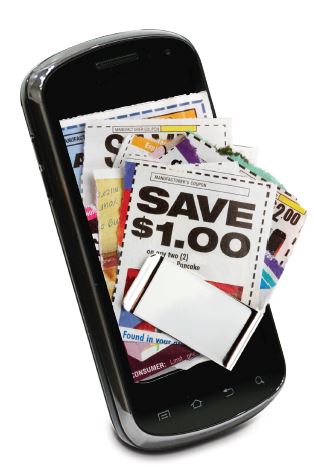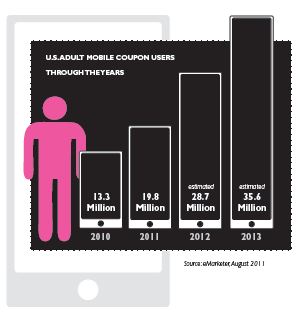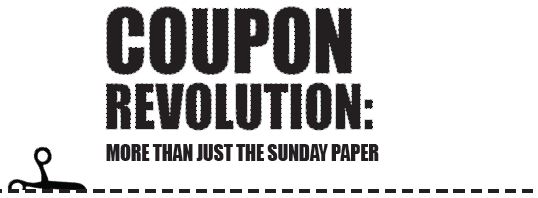 “Coupons” are often a business owner’s nightmare. Every business’s main goal is to make a profit, and thinking about lessening the margin of profit over costs is enough to make anyone wince. But discounts and coupons can help profits soar in more ways than one – the secret is to choose the right kind and to effectively implement it.
“Coupons” are often a business owner’s nightmare. Every business’s main goal is to make a profit, and thinking about lessening the margin of profit over costs is enough to make anyone wince. But discounts and coupons can help profits soar in more ways than one – the secret is to choose the right kind and to effectively implement it.
Coupons have proven they are not going away anytime soon. According to ilovecouponmonth.com, “79.8 percent of consumers regularly shopped with coupons in 2012, compared to 63.6 percent during pre-recession 2007.” There is also a rise in coupons being used from smartphones, downloads from the Internet, customers’ inboxes and mobile apps, an evolution from the familiar scissor and paper coupons of the past. Regardless of how the discount is presented and distributed, if your store is not taking advantage of this form of marketing, then the time to consider is now.
Back to Basics
When it comes to coupons, no one medium has been proven to be revolutionary. This isn’t a case of the most modern method wins – sometimes the most basic of coupons have shown to be the most effective. Whether tearing out a perforated coupon from a direct mailer or cutting out the coupons from the Sunday paper, even as technology leaps forward, nothing is more nostalgic than cutting out a piece of paper and handing it over in exchange for a discount.
The two most basic forms of discounts given on a coupon are a set percentage off the total of a product or subtotal, or “Buy X, Get Y Free.” Punch cards are a form of loyalty card that customers of all ages can’t get enough of. If so many products have been purchased and punched on a card the customer keeps bringing back, then the last punch gives them a reward. Another version of loyalty cards are the ones where rewards are tracked digitally by purchases and each time it’s swiped there is often a chance of receiving a discount or giveaway – Panera is one chain leading the charge on this.
Modernization
While the most basic of coupons can be beneficial, staying on par with technology can make your business stand out from the competition. In 2013, Nielsen reported that 34% of consumers who shop from their smartphones also use technology to access coupons and weekly deals. Whether it’s a bar code that requires scanning or just showing the store the coupon was received, digital coupons allow instant and easy access to deals. There are many
free and low-priced options out there for sending coupons directly to customers’ mobile phones, it’s just a matter of finding one that works for your business’s needs.
There are also unique types of discounts that have popped up recently and started to catch on with consumers. Having coupons that relate to the weather is a popular one. In the dessert world, businesses tend to be slower on rainy or cold days. To entice customers, businesses can offer discounts or a special dish. Creative deals can help drive store traffic when otherwise customers would stay home. If your business thrives on the weekends then offering certain deals during the week helps alleviate those weekday blues.
Customer-Targeted
People love nothing more than to feel important. Appealing to this emotion has proven its effectiveness time and again. Finding the right niche to target is key. The most obvious group to focus on is social media followers. Post a printable or mobile coupon to Facebook and Twitter for your customers to bring in. Having coupons printed in a consumer-specific or a neighborhood-specific magazine can help target certain demographics such as families versus singles, or certain income brackets that match your business.
Another demographic that can’t get enough of discounts are students, either high school or college. If your business is located near a major school or university, asking students to present their I.D.s upon checkout for discounts has proven effective to generate lines of hungry students down the street.
Limited-Time Offers
The worst mistake to make when offering a discount is to not have a limit. Having discounts offered within a very specified time period or for only the first-come-first-serve customers forces avid consumers to act. If there is no time or quantity limit then a customer could sit with that coupon and not use it for an indefinite time.
Rarity is another element of couponing that proves to be effective. If your business offers a discount on a regular basis, a customer or potential customer might hold out to see if a better one is given later on. Discounts given on a set schedule are beneficial for loyal customers that are observant of when the best coupons are available. Think along the lines of buy one, get one free Tuesdays or promotions on a certain day of the month.
More Value than Money
Sometimes coupons are never used, but that doesn’t mean they weren’t effective in driving customers. Coupons alone are an effective and simple marketing tool for sharing visibility of your brand. Pairing the discount with a product and then displaying the deal grabs consumers attention. Giving examples on the coupon of what is included in the discount also entices consumers even more.
There are those who forget their coupons, but still make it to the store or restaurant – it’s happened to the best of us. Forgetting a coupon isn’t generally a big deterrent from leaving a store or restaurant, however shops that honor the coupon often get extra customer service points. To be more customer-friendly, offering discounts in-store brings customers back to the store investigating what’s on sale on this visit.
Numbers Don’t Lie
Nothing could be more important when implementing a discounting strategy than to look back at the numbers to see its effectiveness. If your shop is offering more than one discount at a time, keep track of which discount was used in a purchase before it gets lost in the numbers. Modern POS systems allow cashier’s to enter a discount code, storing electronically which codes were used and how many times. If sticking with printed coupons make sure employees keep an accurate collection of coupons – don’t use the same printed coupon more than once. Sometimes the type of discounts to offer is very apparent, other times it all boils down to trial-and-error.
No matter what method of discounts you decide to offer, the coupon must be precise and clear to the customer. Inmar conducted a consumer study in 2013 of Coupon Trends that focused on consumer behavior. The study found that “32 percent of [consumers] are not always sure of the coupon’s purchase requirements and shoppers expect coupon policies to be clear.” Unclear and disorganized coupon systems and design will hurt a business, but creativity and ingenuity can help your business stay on top.

